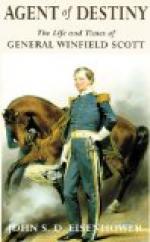The right wing having remained at Tampa Bay from April 5th to the 13th, General Scott issued orders to General Clinch to move toward Fort Drane, and, after relieving Major Cooper, to co-operate with Colonel Lindsay, who had left Fort Brooke about the same time, for the purpose of penetrating the cove in a different direction from that pursued by the right wing on its march to Tampa, and to penetrate the forks of the Ouithlacoochee.
While Colonel Lindsay was engaged in constructing a defensive work on the military road near Big Ouithlacoochee, General Clinch encamped near Fort Cooper and dispatched some cavalry under Captain Malone to relieve the garrison, with instructions that should he meet the enemy, he was to advise General Clinch at once. When about three miles distant from the main body the Indians opened fire and at once retreated. The hammock was penetrated and searched, but no Indians were found.
Major Cooper was attacked by a large body of Indians and besieged for thirteen days. His loss was one man killed and twenty wounded. The Indians not having been found in any large numbers, the two wings separated, the center returning to Fort Brooke and the right to Fort King, where they arrived April 25th.
After the arrival of Colonel Goodwyn’s mounted regiment, the left wing, accompanied by General Scott, took up line of march on the 18th for Volusia. A small party of Indians was encountered, but they fled and secreted themselves in a hammock. General Eustis’s command arrived at Volusia on the evening of the 25th, and on the 28th all the volunteers from South Carolina marched to St. Augustine and were mustered out. On the arrival of Colonel Lindsay at Fort Brooke he was directed by General Scott to relieve the garrison at Fort Alabama, and disband the Alabama volunteers, leaving only regulars there.
They were attacked by the Indians with a loss of four killed and nineteen wounded. General Scott, accompanied by Colonel Gadsden, Captain Augustus Canfield, and Lieutenant Johnson, with a detachment of seventeen men, embarked in a steamboat at Volusia for the purpose of penetrating by the St. John’s River the south part of the peninsula and selecting a site nearer to the seat of war as a depot for supplies. They proceeded to the head of Lake Monroe, but the boat was unable to pass the bar and they were compelled to return.
In his report of April 30th General Scott says: “To end this war, I am now persuaded that not less than three thousand troops are indispensable—two thousand four hundred infantry and six hundred horse, the country to be occupied and scoured requiring that number.” He further recommended that two or three steamers with a light draught of water, and fifty or sixty barges capable of carrying from ten to fifteen men each, be employed, but did not ask for the control of the operations he recommended, saying it was an honor he would neither solicit nor decline.




